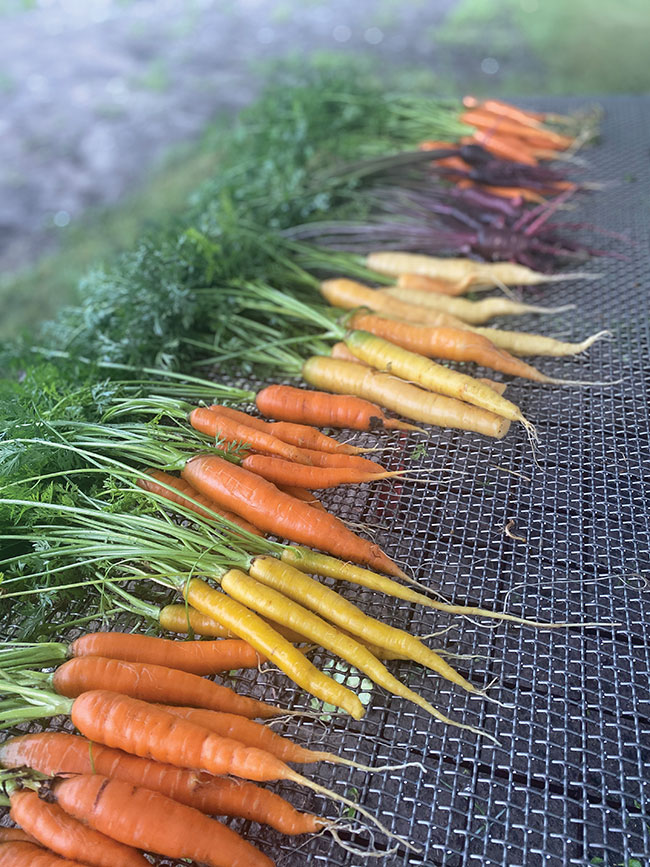
Features
Business
Markets
Grow as you grow
Creating a food safety path that grows with you while you expand your market.
October 31, 2023 By Elaine Grant, co-manager, quality and food safety, Perennia
 A diversity of carrots, all cleaned and ready for market.
Photo courtesy of Janet Dawson.
A diversity of carrots, all cleaned and ready for market.
Photo courtesy of Janet Dawson. The most popular inquiry we receive as quality and food safety specialists is: “Our business is ready to grow – how do we get our products into market? What is required?” The answer is not always simple, nor is it one-size-fits-all. There are many variables to consider: is your product fresh, frozen, further processed or value-added? The intended market, desired retailers’ and destination country requirements you need to meet when exporting will also need to be explored.
Assuming that your product is fruit and vegetable only and you currently sell your product locally, such as at a farmer’s market, farm gate, online or to a few small, local businesses, there are various factors to consider. Depending on the provincial requirements, you may be required to have a food handlers’ course, be a registered farm and have a pesticide license. You may already meet those requirements and have some experience in product-testing and interacting with provincial inspectors but lack knowledge in other areas that are essential to get your products into different markets.
Before starting your path to retail or other markets, it is best to pause and think about where you want your business to be in the next six months, one year, three years and five years. What are your staffing needs? What expertise do you have or need to source out? Are the costs and time worth your efforts, or do you need to push this timeline further ahead? These questions are not to discourage the growth of your business but rather to approach your business plan in a realistic manner. The excitement of your products becoming popular in your current market can make you forget about all that is required in preparation for that growth. It is much easier to start tackling some of the requirements early, so you do not feel rushed or overwhelmed. This will also help you foresee any potential quality issues that may pop up when volumes increase or you encounter a cash crunch when these golden opportunities arise.
Look at where you are currently growing, processing (if applicable), storing, packaging and distributing your product. Would it meet federal requirements? Do you have the space to expand? Product storage, equipment and packaging materials, as well as working space are often the most quickly outgrown areas in a facility. Equipment that works well on a smaller scale may not meet requirements or may not be ideal for storing (think space constrictions and refrigeration unit needs), transporting and packing your product on a larger scale. Additionally, hand-washing and equipment sinks are often overlooked, frequently located in the wrong location and may be insufficient for the number of employees you will need to hire when scaling up your operation. If you are producing or packing in a commercial kitchen, shared space or at home, these locations will be challenging, if not impossible, to get federally licensed or third-party certified.
After you have the facility considerations taken care of, you are ready to add to or start the development of policies, procedures and records. Depending on your product, you may refer to CanadaGAP or GlobalGAP for best practices or even decide to work toward certification. If federal licensing is more in line with your goals, you may explore CFIA’s Safe Food for Canadians Regulations (SFCR), developing and implementing Preventive Controls and a Preventive Control Plan. When a SFCR program is properly documented and implemented to accurately reflect your product and processes in a realistic but compliant manner, the program can readily grow with you, and it can be updated to meet new food safety requirements as your business progresses.
If you choose to pursue third-party certifications, you will need to determine which standard or GFSI scheme is right for you and your potential/current retail market. Once you decide this, there are a few considerations when choosing a certification body to conduct the third-party audit. Do they audit to the standard or GFSI scheme of choice? Do they have local auditors to help save on travel costs? What is their availability and overall costs of an audit?
For most food safety standards, it takes at least three months to have records in place and filled out, six months to have your quality and food safety program fully implemented, and a minimum of a year to have an audit date secured with the certification body of your choice. You will also need to ensure that someone on your team has quality and food safety training, as this is a common requirement for most standards/schemes. Signing up for information sessions allows you to understand what is needed.
There are many things to consider when choosing to expand your market. However, when planned and approached properly, the development and implementation will grow as you grow.
Elaine Grant is a co-manager, quality and food safety, at Perennia Food and Agriculture located in Nova Scotia. Perennia’s Quality and Food Safety team has developed resources which are available for download on their website and provide food safety training. Their team is experienced in assisting in food safety program development both virtually and onsite across several different commodities and quality and food safety standards.
Print this page